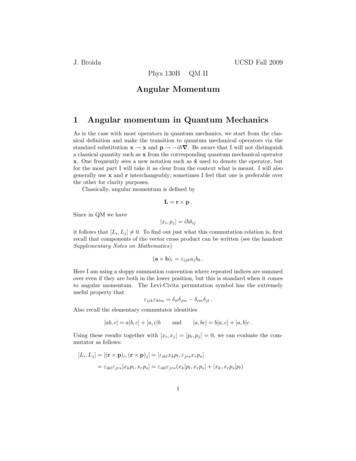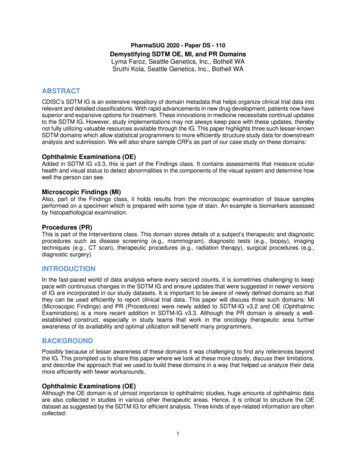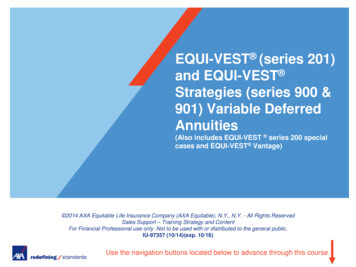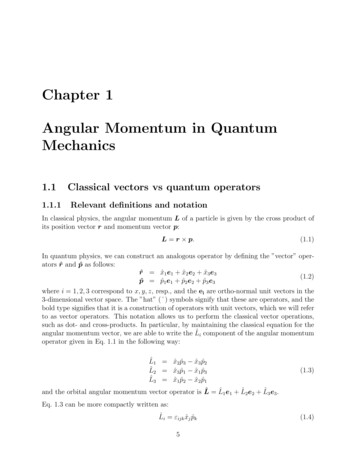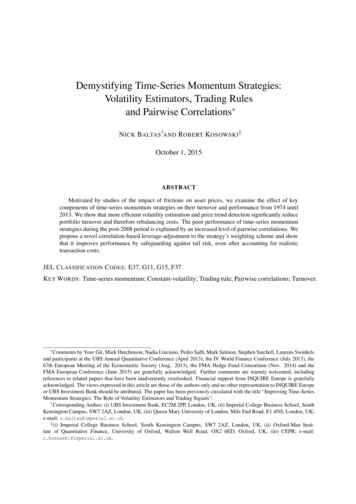
Transcription
Demystifying Time-Series Momentum Strategies:Volatility Estimators, Trading Rulesand Pairwise Correlations N ICK BALTAS†AND ROBERT KOSOWSKI‡October 1, 2015ABSTRACTMotivated by studies of the impact of frictions on asset prices, we examine the effect of keycomponents of time-series momentum strategies on their turnover and performance from 1974 until2013. We show that more efficient volatility estimation and price trend detection significantly reduceportfolio turnover and therefore rebalancing costs. The poor performance of time-series momentumstrategies during the post-2008 period is explained by an increased level of pairwise correlations. Wepropose a novel correlation-based leverage-adjustment to the strategy’s weighting scheme and showthat it improves performance by safeguarding against tail risk, even after accounting for realistictransaction costs.JEL C LASSIFICATION C ODES : E37, G11, G15, F37K EY W ORDS : Time-series momentum; Constant-volatility; Trading rule; Pairwise correlations; Turnover. Comments by Yoav Git, Mark Hutchinson, Nadia Linciano, Pedro Saffi, Mark Salmon, Stephen Satchell, Laurens Swinkelsand participants at the UBS Annual Quantitative Conference (April 2013), the IV World Finance Conference (July 2013), the67th European Meeting of the Econometric Society (Aug. 2013), the FMA Hedge Fund Consortium (Nov. 2014) and theFMA European Conference (June 2015) are gratefully acknowledged. Further comments are warmly welcomed, includingreferences to related papers that have been inadvertently overlooked. Financial support from INQUIRE Europe is gratefullyacknowledged. The views expressed in this article are those of the authors only and no other representation to INQUIRE Europeor UBS Investment Bank should be attributed. The paper has been previously circulated with the title “Improving Time-SeriesMomentum Strategies: The Role of Volatility Estimators and Trading Signals”.† Corresponding Author; (i) UBS Investment Bank, EC2M 2PP, London, UK, (ii) Imperial College Business School, SouthKensington Campus, SW7 2AZ, London, UK, (iii) Queen Mary University of London, Mile End Road, E1 4NS, London, UK;e-mail: n.baltas@imperial.ac.uk.‡ (i) Imperial College Business School, South Kensington Campus, SW7 2AZ, London, UK, (ii) Oxford-Man Institute of Quantitative Finance, University of Oxford, Walton Well Road, OX2 6ED, Oxford, UK, (iii) CEPR; e-mail:r.kosowski@imperial.ac.uk.
1. IntroductionManaged futures funds, also known as Commodity Trading Advisors (CTAs), constitute a significantpart of the hedge fund industry. Using BarclayHedge estimates at the end of 2014, managed futuresfunds manage a total of 318bn. of assets, which is about 11% of the 2.8tr. hedge fund industry. Thesefunds typically trade futures contracts on assets in various asset classes (equity indices, commodities,government bonds and FX rates) and profit from systematic price trends1 by the means of time-seriesmomentum strategies; Moskowitz, Ooi and Pedersen (2012) are the first to comprehensively study thesestrategies in the academic literature, whereas Hurst, Ooi and Pedersen (2013) and Baltas and Kosowski(2013) provide statistical evidence that managed futures and CTA funds do employ such strategies.2Time-series momentum strategies are constructed using long and short positions based on a simplemomentum-based trading rule, which is the sign of the past return. The weighting scheme that is employed is an inverse-volatility scheme (Moskowitz et al. 2012); the correlation structure of the portfolioconstituents is not typically incorporated in the weighting scheme. These strategies have recently received considerable investor attention, because, on the one hand they provided impressive diversificationbenefits during the recent global financial crisis (GFC) of 2008, but on the other hand, they have exhibitedrather poor performance during the subsequent post-crisis period between 2009 and 2013. One of thereasons that has been claimed to be responsible for this recent underperformance has been the increasedlevel of correlations across markets and asset classes in the post-2008 period (Baltas and Kosowski 2013).The objective of this paper is twofold. First, we focus on the portfolio turnover implications of thetwo key inputs in time-series momentum strategies, namely the volatility estimator that is used to scalethe asset positions and the trading rule that is used to identify the price trends. In particular, we explorethe benefits in terms of turnover reduction from employing more efficient volatility estimates and fromidentifying more accurately the strength of price trends by means of alternative trading rules. Second,1 Using BarclayHedge estimates at the end of 2014, systematic traders manage 293bn. of assets, which is about 92% of the 318bn. of assets of the managed futures industry.2 Time-series momentum strategies are structurally different from the cross-sectional momentum strategies, “winners minuslosers”, that have been heavily studied in the academic literature, starting from the works of Jegadeesh and Titman (1993,2001) in the equity markets. Cross-sectional momentum effects in futures markets across multiple asset classes have beenrecently documented by Pirrong (2005), Miffre and Rallis (2007) and Asness, Moskowitz and Pedersen (2013). The time-seriesmomentum strategies rely heavily on return serial correlation patterns, whereas the cross-sectional momentum strategies are along-short zero-cost portfolios of securities with the best and worst relative performance during a lookback period, typicallyequal to 12 months.1
the paper studies the dependence of the performance of time-series momentum strategies on the level ofpairwise correlations, with special attention paid to their recent underperformance following the GFC.We introduce a correlation adjustment, which is applied at the portfolio level and reduces the employedleverage at periods of high co-movement, in order to safeguard against tail risk.As part of our turnover reduction analysis, we first document the economic value of using a volatilityestimator with desirable theoretical properties. In particular, in the spirit of Fleming, Kirby and Ostdiek(2003), we hypothesise that more efficient and accurate estimators, than those constructed using dailyclose-to-close returns, can safeguard against excessive rebalancing and therefore reduce the turnover andimprove the performance of the strategy after transaction costs. By employing a range-based estimator(constructed using open-high-low-close prices), such as the one proposed by Yang and Zhang (2000),we empirically find that the turnover of the strategy is reduced by almost one tenth without affecting therisk-adjusted performance of the strategy before incorporating any trading costs. Importantly, the benefitin the turnover reduction is not due to a small number of portfolio constituents, but instead it is found tobe pervasive across all portfolio constituents from all asset classes.The typical momentum trading rule in the literature uses the sign of the past return over the past 12months (Moskowitz et al. 2012). Our analysis shows that the frequency at which a trading rule switchesbetween long and short positions can dramatically affect the portfolio turnover. Intuitively, avoiding theexcessive position changes when no significant price trend exists can significantly reduce the turnoverand therefore improve the performance of the strategy after accounting for transaction costs. Therefore,we evaluate the properties and investment implications of a trading rule that only instructs taking a longor a short position when the underlying price trend is statistically significant. By effectively timing theentry to and the exit from a particular position we find that the turnover of the strategy falls largely bytwo thirds compared to using the sign of the past returns.Our second objective is to study the dependence of the performance of the time-series momentumstrategy on the level of pairwise correlations of portfolio constituents. This analysis is motivated by thefindings in Baltas and Kosowski (2013), who, apart from documenting the business cycle performanceof the strategy, also highlight its poor performance after 2008. The authors explain that the underperformance can be due to (i) capacity constraints in the futures markets, (ii) a lack of trends for each asset2
or (iii) increased correlations across assets. They find no evidence of capacity constraints based on twodifferent methodologies, but they do show that correlations between futures markets have experienced asignificant increase in the period from 2008 to 2013.We show that incorporating the pairwise correlations of the constituent assets into the weightingscheme of the time-series momentum strategy not only sheds light on the return drivers of time-seriesmomentum strategies, but can also significantly improve their out-of-sample performance in the yearsfollowing the GFC. We investigate the interplay between the pairwise correlations of portfolio constituents and the portfolio volatility and extend the formulation of the standard time-series momentumstrategy by introducing a correlation factor in the weighting scheme that increases (decreases) the leverage of portfolio constituents in periods of low (high) average pairwise correlation. This adjustmentimproves the risk-adjusted performance of the strategy, because it actively safeguards against crash risk.The improvement is relatively more pronounced over the most recent post-crisis period 2009-2013 during which pairwise correlations across assets and asset classes dramatically increased, thus, diminishingdiversification benefits. In particular, the Sharpe ratio of the strategy over this period more than doubles(from 0.14 to 0.29) after employing the correlation adjustment. Nevertheless, the performance benefitdoes not come at no cost, as the turnover of the strategy increases.The various methodological adjustments that we discuss in this paper have different turnover implications for the time-series momentum strategy; more efficient volatility estimation and price trend detection result in turnover reduction, whereas incorporating pairwise correlations increases the turnover atthe benefit of improved portfolio diversification. In order to evaluate the economic impact of differencesin turnover on strategy returns, we construct our time-series momentum strategies using a comprehensive dataset of 75 futures contracts over a period of 36 years and we use the simple approximation fortransaction costs of Frazzini, Israel and Moskowitz (2012). Under this costs model, the realised costs ofa strategy are proportional to portfolio turnover and an average market impact level; the market impact isassumed constant for our analysis, even though in practice the market impact typically depends, amongother things, on the order size. Contrary to expectations and based on this model, the turnover and costsreduction that is achieved by more efficient volatility estimation and price trend detection does not lead tosignificantly higher risk-adjusted performance of the time-series momentum strategy. However, the performance improvement of the strategy due to the incorporation of pairwise correlation in the weighting3
scheme is shown to be robust to the increased trading costs.Our paper is related to several streams of the literature including work on the economic value ofvolatility-timing and the importance of volatility estimation efficiency on dynamic portfolio construction and turnover. Fleming, Kirby and Ostdiek (2001), Ilmanen and Kizer (2012), Kirby and Ostdiek(2012) and Hallerbach (2012) highlight the benefits of volatility-timing, while Barroso and Santa-Clara(2015) and Daniel and Moskowitz (2015) examine its effect on the performance of cross-sectional equity momentum strategies. Fleming et al. (2003) investigate the performance and turnover benefits for amean-variance portfolio from using more efficient estimates of volatility. We make use of range volatilityestimators in order increase the estimation of efficiency of daily estimators.The rest of the paper is organised as follows. Section 2 provides an overview of the dataset andSection 3 describes the construction of the time-series momentum strategy, explores the dependence ofthe strategy’s turnover on volatility estimator and trading rule and introduces the correlation adjustment.The empirical results of the effects of volatility estimator and trading rule on the turnover of time-seriesmomentum strategies are presented in Section 4. Section 5 discusses the recent underperformance ofthe time-series momentum strategies and presents our empirical results on the effect of incorporatingpairwise correlations in the weighting scheme onto the performance of these strategies. Section 6 reportsthe transaction cost implications of all the methodological alterations that are presented over the courseof the paper and finally, Section 7 concludes.2. Data DescriptionThe dataset that we use is based on the one used by Baltas and Kosowski (2013) and consists of dailyopening, high, low and closing futures prices for 75 assets across all asset classes: 26 commodities,23 equity indices, 7 currencies and 19 short-term, medium-term and long-term government bonds; seeTable I. It is obtained from Tick Data and the sample period is from December 1974 (not all contractsstart in December 1974; Table I reports the starting month and year of each contract) to February 2013.Since the contracts of different assets are traded on various exchanges each with different trading hoursand holidays, the data series are appropriately aligned by filling forward any missing prices. Finallyand especially for equity indices, we also obtain spot prices from Datastream and backfill the respective4
futures series for periods prior to the availability of futures data.3Futures contracts are short-lived instruments and are onl
Demystifying Time-Series Momentum Strategies: Volatility Estimators, Trading Rules and Pairwise Correlations NICK BALTAS†AND ROBERT KOSOWSKI‡ October 1, 2015 ABSTRACT Motivated by studies of the impact of frictions on asset prices, we examine the effect of key components of time-series momentum strategies on their turnover and performance from 1974 until 2013. We show that more
